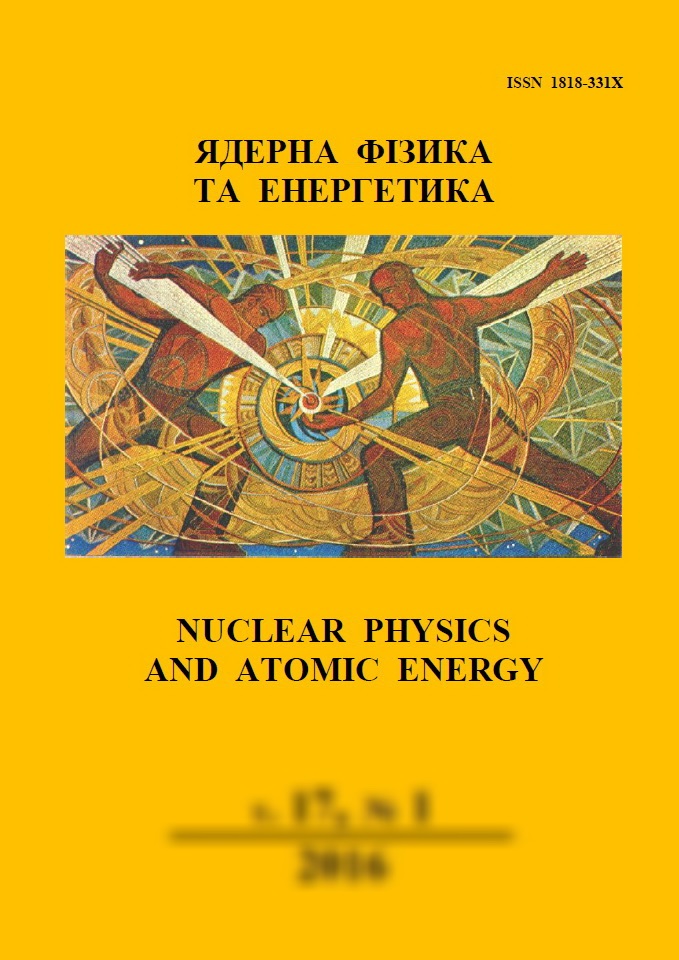 |
Ядерна фізика та енергетика
Nuclear Physics and Atomic Energy
ISSN:
1818-331X (Print), 2074-0565 (Online)
Publisher:
Institute for Nuclear Research of the National Academy of Sciences of Ukraine
Languages:
Ukrainian, English, Russian
Periodicity:
4 times per year
Open access peer reviewed journal
|
Nucl. Phys. At. Energy 2019, volume 20, issue 2, pages 159-163.
Section: Atomic Energy.
Received: 01.06.2018; Accepted: 26.12.2018; Published online: 27.08.2019.
 Full text (en)
Full text (en)
https://doi.org/10.15407/jnpae2019.02.159
Analysis of nuclear safety in diversification of Westinghouse fuel assemblies at WWER-1000
V. I. Skalozubov, I. L. Kozlov*, Yu. A. Komarov, O. A. Chulkin, O. I. Piontkovskyi
Odessa National Polytechnic University, Odesa, Ukraine
*Corresponding author. E-mail address:
kozlov_i.l_@ukr.net
Abstract:
The research presents an analysis of the known results in modeling the maximum design accident (MDA) using the code RELAP5/V3.2 with Westinghouse fuel assemblies’ (WFA) diversification in WWER-1000 reactors. According to the known results of MDA calculated model simulation with RELAP5/V3.2 code at the maximum allowable water temperature in the heat WWER emergency cooling system exchanger (90 °С), the fuel elements’ claddings temperature reaches 1320 °С and exceeds the admissible nuclear safety limit (1200 °С). Thus, according to known results, these MDA with WFA engaged pass from the "design" accident status to the "severe" accident status and means a decrease in safety in relation to the FA-A fuel assemblies. The alternative MDA analysis for WFA-equipped plants showed that, unlike the known calculations, the nuclear safety limit on the maximum permissible fuel cladding temperature is not violated and never reduces the overall safety level in WWER diversification with WFA fuel assemblies.
Keywords:
security, diversification of fuel assemblies.
References:
1. M. Kirst, U. Benjaminsson, C. Önneby. Diversification of the VVER Fuel Market in Eastern Europe and Ukraine. ATW 60(3) (2015) 171.
https://www.kernd.de/kernd-wAssets/docs/fachzeitschrift-atw/2015/atw2015_03_kirst_vver_fuel.pdf
2. D. Ernst, L. Milisdorfer. 10 years of experience with Westinghouse fuel at NPP Temelin. In: Int. Topical Meeting VVER-2010 Experience and Perspectives, Prague, Nov. 1 - 3, 2010. 30 p.
3. J. Höglund et al. Performance of the Westinghouse WWER-1000 fuel design. In: Int. Conf. on WWER Fuel Performance, Modelling and Experimental Support, Bulgaria, Helena Resort, Sept. 17 - 24, 2011.
4. S. Kaichao. MCNP modelling of hexagon VVER fuel. Master of Science thesis (Stockholm: Royal Institute of Technology, 2008) 75 p.
5. V.I. Skalozubov et al. Scientific and Technical Bases for Measures to Improve the Safety of NPPs with VVER (Chernobyl: Institute for Safety Problems of NPPs, NAS of Ukraine, 2010) 200 p. (Rus)
6. I.A. Shevchenko, Yu.Yu. Vorobyev. Verification of safety criteria for mixed fuel loadings for VVER-1000 type reactors. Yaderna ta Radiatsiyna Bezpeka 2(66) (2015) 3. (Rus)
http://www.sstc.com.ua/documents/journal/2015/2/text/1_2_2015_text.pdf
7. A.A. Klyuchnikov et al. Thermophysics of Nuclear Power Plants Safety (Chernobyl: Institute for Safety Problems of NPPs, NAS of Ukraine, 2010) 484 p. (Rus)
8. P.L. Kirillov, Yu.S. Yuriev, V.P. Bobkov. Handbook of Thermal Calculations (Moskva: Energoatomizdat, 1990) 360 p. (Rus)
9. V.N. Vasilchenko et al. Simulation of Accidents at Nuclear Power Plants (Odessa: Rezon, 2002) 466 p. (Rus)
10. V.I. Skalozubov, A.A. Klyuchnikov, V.N. Kolykhanov. Management Basics of Severe Accidents with Loss of Coolant at VVER Nuclear Power Plants (Chernobyl: Institute of Safety Problems of NPPs, NAS of Ukraine, 2010) 400 p. (Rus)
11. Analysis of differences in fuel safety criteria for WWER and western PWR nuclear power plants. IAEA-TECDOC-1381 (IAEA, 2003) 53 p.
IAEA-TECDOC-1381
12. V.V. Ivanov. Reactor core monitoring in terms of mixed fuel loading. In: Symposium during International Youth Nuclear festival Dysnai. Technical section (Lithuania, Visaginas, 2002).
